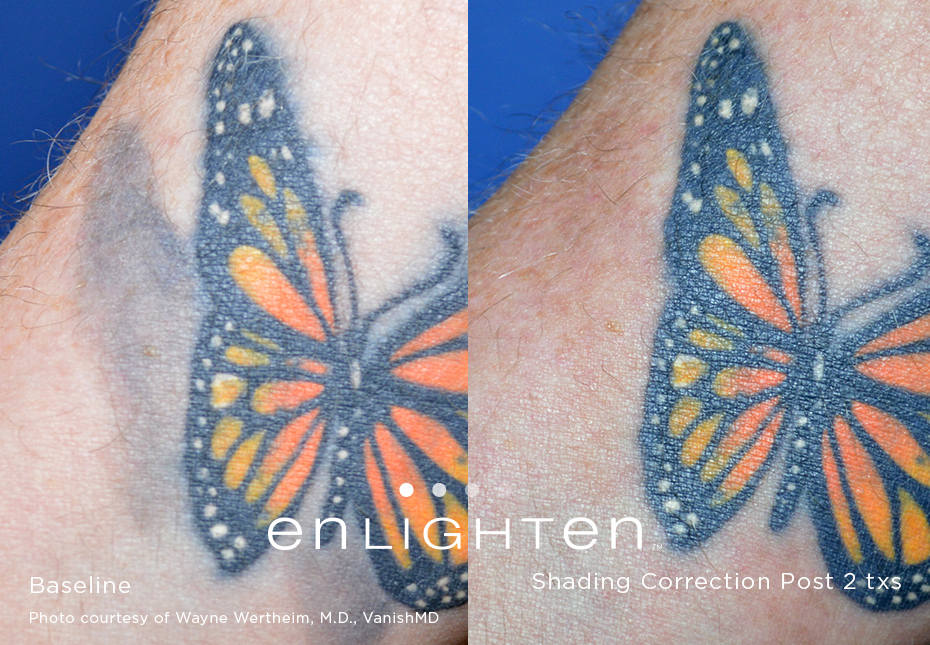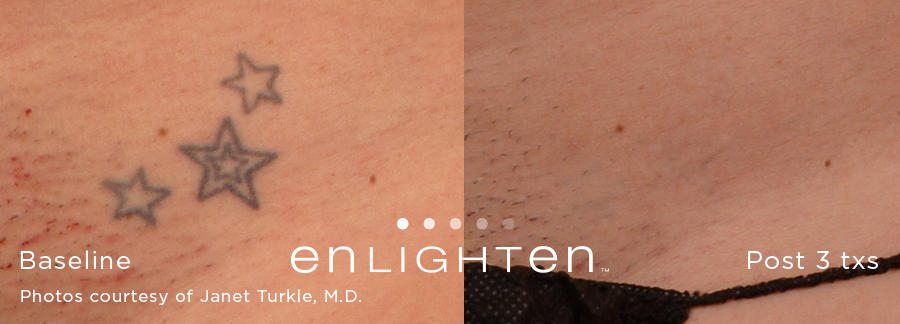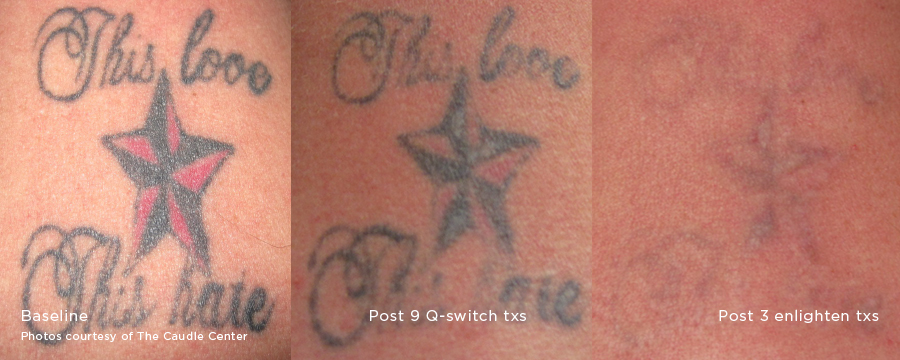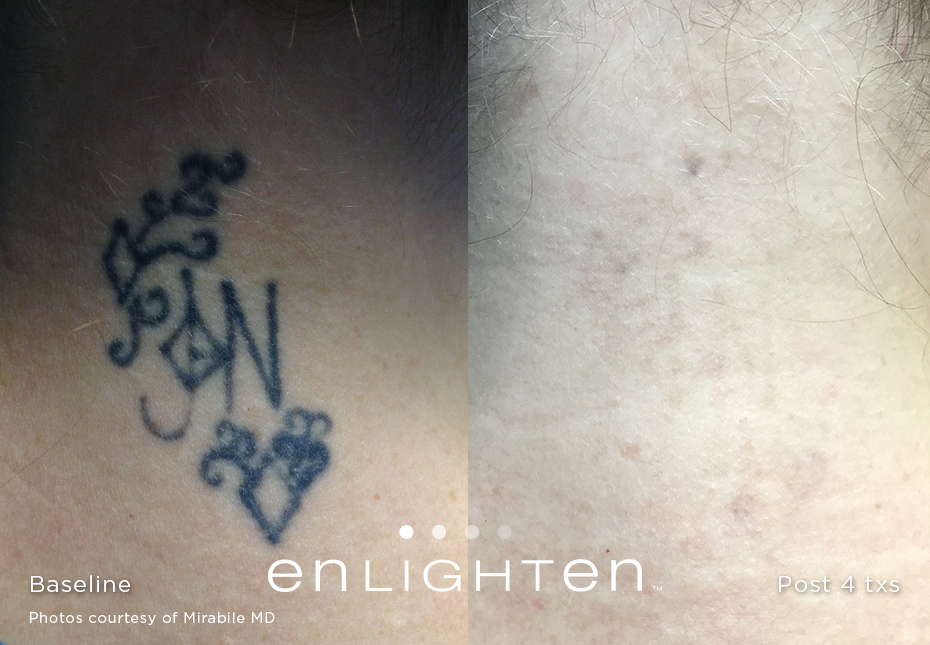
Laser Tattoo Removal
advanced laser system
What is tattoo removal?
Tattoo removal can be achieved in a number of ways, ranging from laser treatments, chemical peels, dermabrasion, and surgical excision.
Tattoo Removal Laser Treatments
Lasers are the most common method of tattoo removal performed today. Tattoos consist of thousands of particles of tattoo ink suspended in the skin. The normal human immune system typically removes small foreign particles from the skin. Tattoo ink particles are too big to be removed by this system and are thus considered permanent. The use of lasers helps to break up these particles into smaller pieces that can be removed by the immune system.
Laser treatments work by targeting the ink particles in the skin with highly concentrated light waves that heat up the ink particles and cause them to fragment into smaller particles that are able to be cleared away by the body's immune system.
Depending on the tattoo design, size, and color, it may take 1-10 laser sessions to remove the ink. Some colors of ink are harder to remove than others and may not be able to be completely removed. There should be a six-week time period between each laser session to allow the wounds to heal and the body to absorb as much of the ink as possible.
Who is a good candidate for tattoo removal?
All tattoos can be considered for removal. If you are considering having a tattoo removed, visit a board-certified plastic surgeon to discuss options for tattoo removal and reasonable expectations.
You may be a candidate for tattoo removal if:
- Are physically healthy
- Don't smoke
- Have realistic expectations
What should I expect during a consultation for tattoo removal?
The success and safety of your tattoo removal procedure depend greatly on what you discuss during your initial consultation. You'll be asked a number of questions about your health, desires, and lifestyle.
During your tattoo removal consultation, be prepared to discuss:
- Your tattoo removal goals
- Any medical conditions or allergies
- Current medications, vitamins, herbal supplements, alcohol, tobacco, and drug use.
Be sure to ask your plastic surgeon questions. It's very important to understand all aspects of your tattoo removal procedure.
Enlighten Laser Tattoo Removal Advanced Laser System
What is enlighten?
enlighten™ is the most advanced laser energy system for the effective and safe removal of tattoos and benign pigmented lesions in the treatment area in fewer sessions. It is much more effective than older laser technologies.
How does enlighten laser technology differ from other laser tattoo removal options?
enlighten™ features extremely short and high-power picosecond laser pulses that efficiently and quickly break down the ink particles in tattoos without affecting the surrounding skin. A "picosecond" is one-trillionth of a second, and is 1000 times shorter than the "nanosecond" pulses used in existing lasers for tattoo removal. Picosecond laser pulses have been shown to remove tattoos more completely and in fewer treatment sessions than traditional lasers used historically.
How many sessions are required?
The total number of treatments varies depending on the composition, depth, and color of the ink, as well as the size of the tattoo. You should be prepared for multiple treatment sessions, and your provider can give you a better idea of the total number of treatments needed during your consultation.
Why are multiple sessions required?
Tattoo ink is deposited deep in the skin. In order to reach all of the ink in the skin, multiple treatment sessions are needed. Depth, size, and color of the tattoo pigment also impact the number of necessary treatments.
Will the tattoo completely disappear?
In many cases, yes, your unwanted tattoo will completely disappear. However, it is very important to know that some ink colors are more difficult to clear than others.
Is the procedure painful?
Patients compare the procedure to a rubber band snapping sensation against their skin. Topical or local anesthetics may be available to minimize discomfort.
What are the risks of tattoo removal?
The decision to have a tattoo removed is extremely personal. Only you can decide if the benefits of tattoo removal will achieve your goals and if the risks and potential complications of tattoo removal are acceptable.
The potential risks of tattoo removal include, but are not limited to:
- Infection
- Poor wound healing
- Unfavorable scarring
- Skin discoloration that may be permanent
- Suboptimal aesthetic results
- Possible need for further surgery
What should I expect during my recovery after tattoo removal?
After your laser tattoo removal, you will have a gauze bandage applied to the area after the procedure is done. Your surgeon will discuss with you how to care for the area after the procedure is done. Typically, this will require no more than washing the area daily with soap and water and applying a new gauze dressing.
You will be given specific instructions that may include:
- How to care for your surgical sites following the procedure
- Medications to apply or take orally to aid healing and reduce the risk of infection
- Specific concerns to look for at the surgical site or in your general health
- When to follow up
Is there any downtime associated with the treatment?
There is very minimal downtime. Patients can return to regular activities immediately following treatment.
What results should I expect after tattoo removal?
The results of tattoo removal are variable depending on your unique tattoo. Each session will show some progress toward the final result, though the number of treatments needed to achieve your final result may vary.
Results for tattoo removal are dependent on factors such as:
- The type of procedure used
- The area of the body where the tattoo is located
- The size of the tattoo
- The complexity of the design of the tattoo
- The color of the ink used in the tattoo
